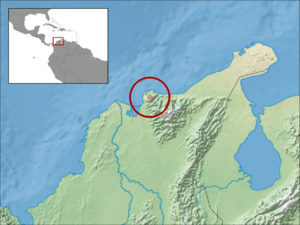Red-crested tree-rat facts for kids
Quick facts for kids Red-crested tree-rat |
|
|---|---|
 |
|
| Illustration of Santamartamys rufodorsalis | |
| Conservation status | |
| Scientific classification | |
| Genus: |
Santamartamys
|
| Species: |
rufodorsalis
|
 |
|
| Synonyms | |
|
|
The red-crested tree-rat or Santa Marta toro (Santamartamys rufodorsalis) is a special type of tree-rat. It belongs to a unique group called Santamartamys within the Echimyidae family. This animal is active at night, which means it is nocturnal. Scientists believe it eats plants. Its fur is mostly reddish-brown, but young ones have grey fur.
The red-crested tree-rat is listed as critically endangered. This means it is at a very high risk of disappearing forever. Threats to this animal include feral cats, changes in climate, and forests being cut down in its home in Colombia.
Only three red-crested tree-rats have ever been seen by scientists. The first was found in 1898, another in 1913, and the most recent one in 2011. They live in the Sierra Nevada de Santa Marta mountains, high up between 700 and 2,000 meters. This area in Colombia is very special because it has many different kinds of plants and animals found nowhere else. The species was first named Isothrix rufodorsalis in 1899. Later, it was called Diplomys rufodorsalis in 1935. Finally, in 2005, scientists created the special group Santamartamys just for this unique rat.
Contents
Discovery of the Red-Crested Tree-Rat
The first red-crested tree-rat was found on December 24, 1898. It was identified by Herbert Huntingdon Smith in Ocana, Santa Marta, Colombia. Local hunters collected all of Smith's specimens, so we don't know the exact spot where this rat was found.
A second tree-rat was discovered around 1913. It was found in the Sierra Nevada de Santa Marta by Melbourne Armstrong Carriker. Not much is known about where or when this one was found either. It was added to the American Museum of Natural History in New York in 1913. Even after many organized searches, no other red-crested tree-rats were seen for a long time.
Then, on May 4, 2011, something exciting happened! Two volunteers from Fundación ProAves took a picture of one of these rats. They found it at 1,958 meters (about 6,424 feet) above sea level. This was in the El Dorado ProAves Reserve. Paul Salaman later confirmed it was a red-crested tree-rat.
Appearance and Features
Red-crested tree-rats are about 20 inches (50 cm) long from their head to the tip of their tail. Their tails alone can be between 18 and 28 cm (7 to 11 inches) long. These rats can weigh up to 500 grams (about 1.1 pounds). They have soft, woolly, and long fur.
Their back fur is a bright red color. A large part of their tail is black, but the last two-fifths of the tail are white. Their ears are small and light brown. They have long hair tufts on the inside of their ears. There's also a tuft of long black hairs between their eye and ear. Their thin whiskers can grow up to 5 inches (13 cm) long. They also have a strip of red fur around their neck.
The upper parts of their front and back legs are covered in pale grey fur. Their hind legs are short and wide. Their feet do not have small bumps. The thumb has a nail instead of a claw.
Young red-crested tree-rats have grey fur. As they grow older, their fur changes to the bright red color. This change starts at the front of their body and moves backward.
Behavior and Habitat
The red-crested tree-rat is a nocturnal rodent. This means it is active at night. We don't know exactly what it eats. However, scientists think it eats plants, like fruits or seeds. Other similar animals in its family, Echimyidae, eat these things. This rat can easily climb up a vertical wooden surface. The one seen in 2011 did not make any sounds.
This animal lives only in Colombia. It has only been found in the Sierra Nevada de Santa Marta mountains. It lives at high altitudes, from 700 to 2,000 meters (about 2,300 to 6,560 feet). This mountain region is very special. It is isolated and has unique weather conditions. Because of this, it has many different kinds of plants and animals found nowhere else. Scientists believe that the places where the red-crested tree-rat lives are being damaged.
How it Got Its Name
The red-crested tree-rat was first described by an American biologist named Joel Asaph Allen in 1899. He originally called it Isothrix rufodorsalis. Later, in 1935, it was moved to a different group called Diplomys by George Henry Hamilton Tate.
In 2005, Louise H. Emmons from the Smithsonian Institution studied this group of animals again. She found that the red-crested tree-rat had many unique features. For example, its teeth were different from other animals in the Diplomys group. Because of these differences, a new, unique group was created just for this species. This new group was named Santamartamys.
The name Santamartamys comes from "Santa Marta," which is part of the name of the place where the rats were found. The word mys means "mouse." The second part of its name, rufodorsalis, comes from Latin. Rufus means "red" and dorsalis means "back." This refers to the red color of the rat's back.
Threats and Conservation
The red-crested tree-rat was seen again on May 4, 2011. This happened in the El Dorado ProAves Reserve. This is a protected area in the Sierra Nevada de Santa Marta mountains. The reserve was set up on March 31, 2006. It covers 1,024 hectares (about 2,530 acres). It is located at altitudes between 950 and 2,600 meters (about 3,117 to 8,530 feet). This reserve is home to many animals and plants that are found nowhere else or are in danger.
In 1990, scientist Emmons thought the red-crested tree-rat was one of the rarest mammals in the Neotropical region. The International Union for Conservation of Nature (IUCN) first called the species "Vulnerable" in 1996. In 2008, the IUCN changed its status to "Data deficient". This was because there wasn't enough information about where it lived, what it did, or its habitat.
After more study in 2011, the species was listed as "Critically endangered". This is the highest risk category before extinction. A lot of the forest where this rat might live has been cut down or damaged. Also, many areas where it could live have feral cats. These cats hunt and eat wild animals. Climate change is also a long-term threat to the red-crested tree-rat.
See also
 In Spanish: Ratón arbóreo de Santa Marta para niños
In Spanish: Ratón arbóreo de Santa Marta para niños



